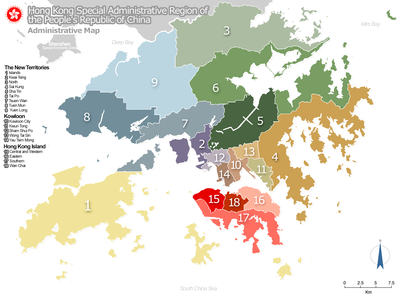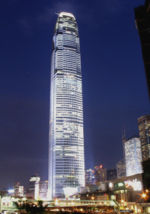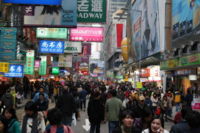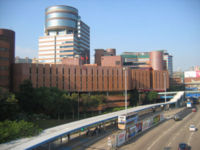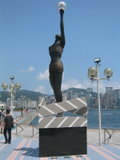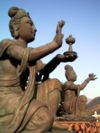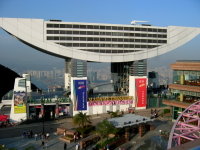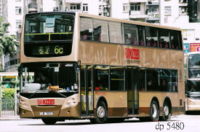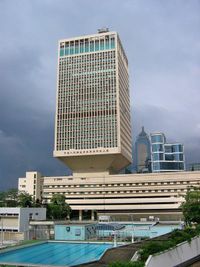Hong Kong
2007 Schools Wikipedia Selection. Related subjects: Asian Countries; Countries
| 中華人民共和國香港特別行政區 Hong Kong Special Administrative Region of the People's Republic of China |
|||||
|
|||||
| Anthem: March of the Volunteers (the national anthem of the People's Republic of China) |
|||||
| Capital | none Historically, the capital was Victoria City; government headquarters are located in the Central and Western District. |
||||
|---|---|---|---|---|---|
| Most populated district | Sha Tin District | ||||
| Official languages | Chinese English |
||||
| Government | |||||
| - Chief Executive | Donald Tsang | ||||
| Establishment | |||||
| - occupied by the UK | January 25, 1841 | ||||
| - Crown colony of the UK | August 29, 1842 | ||||
| - SAR of the PRC | July 1, 1997 | ||||
| Area | |||||
| - Total | 1,104 km² ( not ranked) 426.4 sq mi |
||||
| - Water (%) | 4.6 | ||||
| Population | |||||
| - 2005 estimate | 7,041,000 ( 97th) | ||||
| - 2001 census | 6,708,389 | ||||
| - Density | 6,294.65/km² ( 3rd) 16,469.6/sq mi |
||||
| GDP ( PPP) | 2005 estimate | ||||
| - Total | $254.2 billion ( 40th) | ||||
| - Per capita | $37,400 ( 2006) | ||||
| HDI (2004) | 0.927 (high) ( 22nd) | ||||
| Currency | Hong Kong dollar ( HKD) |
||||
| Time zone | HKT ( UTC+8) | ||||
| - Summer ( DST) | not observed | ||||
| Internet TLD | .hk | ||||
| Calling code | +852 (01 from Macau) | ||||
The Hong Kong Special Administrative Region of the People's Republic of China ( Traditional Chinese: 中華人民共和國香港特別行政區 [ pronunciation]) is one of the two special administrative regions (SARs) of the People's Republic of China (PRC), the other being Macau. It is commonly known as Hong Kong (Chinese: 香 港), which is often written Hongkong in older English-language texts. The Hong Kong Government officially changed the name of Hongkong to Hong Kong on 3 September 1926.
Hong Kong is on the eastern side of the Pearl River Delta on the southeastern coast of the People's Republic of China, facing the South China Sea in the south, and bordering Guangdong Province in the north. Hong Kong has one of the world's most liberal economies and is a major international centre of finance and trade.
Hong Kong was a British colony from 1842, until its sovereignty was transferred to the PRC in 1997. It is governed as a special administrative region under the Basic Law of Hong Kong. Under the terms of the Sino-British Joint Declaration, the PRC has promised that Hong Kong will have a relatively high degree of autonomy until at least 2047, fifty years after the transfer of sovereignty. Under the " One Country, Two Systems" policy, it retains its own legal system, currency, customs policy, cultural delegation, international sport teams, and immigration laws, with the PRC representing Hong Kong diplomatically and militarily.
History
The area now known as Hong Kong became an important trading region and a significant strategic location for the Chinese mainland during the Tang and Song dynasties. These populated townships or villages had never been collectively known as Hong Kong before the British administration. The area began to attract the attention of China and the rest of the world again in the 19th century, when it was ceded to Britain after the Opium Wars. Hong Kong's earliest recorded non-Asian visitor was the Portuguese mariner Jorge Álvares who arrived in 1513. Álvares began trading with the Chinese, and the Portuguese continued to make periodic trade stops at various locations along the coast.
Tea, silk, and other Asian luxury goods were introduced in Europe by the Portuguese, and by the mid-18th century these items were in high demand, particularly tea. The British, to redress their net outflow of payments to China for tea and to force China to conduct relations like other states, invaded China, winning the First Opium War in 1841. During the war, Hong Kong Island was first occupied by the British, and then formally ceded by the Qing Dynasty of China in 1842 under the Treaty of Nanking.
Hong Kong became a crown colony in 1843. The first urban settlement was named Victoria City. The Kowloon Peninsula south of Boundary Street and Stonecutter's Island was ceded to the British in 1860 under the Convention of Peking after the Second Opium War. Various adjacent lands, known as the New Territories (including New Kowloon and Lantau Island), were then leased by Britain for 99 years, from 1 July 1898 to 30 June 1997. For the first 20 years there was little contact between the European and Chinese communities. The first specially-recruited Hong Kong civil servants to be taught Cantonese were recruited in 1862, markedly improving relations.
Hong Kong entered a dark age during the Japanese Occupation of World War II, which lasted for three years and eight months. Many Hong Kongers were executed by the Japanese army during the war. There was a significant resistance movement most notably on Lantau Island. After their defeat by the allied forces, the Japanese surrendered on 15 August 1945. The port was quickly re-opened and welcomed a mass migration of Chinese refugees in 1949 from the civil war. Many refugees escaped to Hong Kong fearing the new Communist government in China.
Hong Kong had been a trade port ever since the British occupation, but its position as an entrepôt declined greatly after the United Nations ordered a trade embargo against the People's Republic of China as a result of the Korean War. In response, a textile industry was established, taking advantage of the new pool of workers from China who were willing to work for almost any wage. During this period, the economy grew extremely rapidly. Towards the 1970s, Hong Kong began to move away from the textile industry and develop its financial and banking economy. This led to even greater growth, and Hong Kong quickly became one of the wealthiest territories in the world. Its position as an entrepôt was revived when the Open Door Policy was adopted by the PRC in the late 1970s under Deng Xiaoping.
In the 1980s, with the lease on the New Territories running out, the British government, led by Margaret Thatcher, decided to negotiate the question of the sovereignty of Hong Kong. Although the British would have been legally required to transfer only the New Territories to the PRC, Whitehall decided that maintaining a rump colony would not be worthwhile - the majority of Hong Kong's land was in the New Territories, and failure to return the entire colony would undoubtedly have generated political friction between the UK and PRC.
Pursuant to an agreement known as the Sino-British Joint Declaration, signed by the People's Republic of China and the United Kingdom on 19 December 1984, the whole territory of Hong Kong under British colonial rule became the Hong Kong Special Administrative Region of the PRC on 1 July 1997. In the Joint Declaration, the PRC promised that under the " One Country, Two Systems" policy proposed by Deng Xiaoping, the socialist economic system in mainland China would not be practiced in Hong Kong, and Hong Kong's previous capitalist system and life-style would remain unchanged for at least 50 years, or until 2047. Hong Kong would enjoy a high degree of autonomy in all matters except diplomatic affairs and national defence.
The Joint Declaration came into particular focus in June 1989 when the PRC authorities in Beijing moved with particular severity against "pro-democracy" demonstrators in Tiananmen Square and elsewhere in Beijing. The loss of life amongst their Chinese brethren in the Chinese capital led to literally millions of Hong Kong Chinese protesting openly in the streets of Hong Kong. In the (then) colony of Hong Kong there was immediate concern about Hong Kong's future, a fall in the stock market and general disquiet.
Hong Kong was transferred to the PRC at midnight on 1 July 1997, with the last governor, Chris Patten, leaving on the royal yacht. Soon after the handover in July, land values in Hong Kong collapsed substantially and expedited the burst of the bubble economy, as part of the Asian financial crisis. This was exacerbated by Tung Chee Hwa's unsubstantiated pledge to supply 85,000 new flats annually ; which essentially manipulated the region's real estate prices. In some areas, land values fell by over half; and the Hang Seng Index fell by over 1,500 points on 28 October 1997, losing 22.8% of its value in a week.
Hong Kong was hit badly by the outbreak of the SARS virus beginning in mid-March through the summer of 2003. This exacerbated the region's economic problems, especially in the effect that it had on travel to and from Hong Kong.
On 1 July the same year, half a million people marched in the largest protest rally ever aimed at the government of Hong Kong, voicing concerns about a proposed anti-subversion bill that would have eroded freedom of the press, of religion and of association arising from Article 23 of the Hong Kong Basic Law, as well as dissatisfaction with the poor state of the economy. Regina Ip, then Secretary for Security, and Antony Leung, then Financial Secretary, were forced to leave office in 2003 under public pressure (though Antony Leung left office for reason unrelated to the SARS and Article 23 crisis, he gave in to public pressure after his involvement in the ' Lexusgate' scandal).
On 10 March 2005, Tung Chee Hwa submitted his resignation as chief executive of Hong Kong. Donald Tsang, the Chief Secretary for Administration of Hong Kong, served as Acting Chief Executive until 25 May, when he, too, resigned to take part in the campaign for the new Chief Executive election. Following an interim government headed by Henry Tang, Tsang was elected as Chief Executive.
Politics and government
The Hong Kong Special Administrative Region is headed by its Chief Executive, the head of government. This office is currently held by Donald Tsang, who was elected on 16 June 2005.
Tsang had held the post of Chief Secretary for Administration previously. He assumed his post on 24 June 2005 in Beijing, China; he will finish the remaining portion of Tung Chee Hwa's last term, which ends on 30 June 2007, according to the interpretation of Annex I and Article 46 by the Standing Committee of the National People's Congress.
The election of a new Chief Executive by the 852-member Election Committee was expected to be held on 10 July 2005. On 16 June 2005, Donald Tsang was acclaimed the winner, as the only candidate securing the required 100 nominations from members of the election committee. Tung Chee Hwa, the first Chief Executive, assumed office on 1 July 1997, following his election by a 400-member electoral college. For the second five-year term of the Chief Executive which began in July 2002, Tung was the only nominated candidate and therefore acclaimed.
The PRC set up a Provisional Legislative Council (PLC) in 1996 just before the handover, where it moved to Hong Kong to have its meetings after the handover. It reverted some laws passed by the colonial Legislative Council, which was formed by means of universal suffrage since 1995. The PLC passed some new laws, such as the Public Order Ordinance, which required permission from police to hold a demonstration where the number of people who participates exceeds 30. Legislative Council elections were held on 24 May 1998, 10 September 2000, and again on 12 September 2004, with the next election scheduled for 2008. According to the Basic Law, Hong Kong's "mini- constitution", the present third term of the Legislative Council has 25 seats directly elected from geographical constituencies, and 30 seats elected from functional constituencies. The 1998, 2000 and 2004 Legislative Council elections were seen as free, open, and widely contested, despite discontent among mainly 'pro-democratic' politicians, who contended that the functional constituency elections and the Election Committee elections (for 1998 and 2000) were undemocratic, as they consider that the electorate for these seats is too narrow.
The civil service of Hong Kong maintains its quality and neutrality following its tradition in the colonial times, operating without discernible direction from Beijing. Many government and administrative operations are located in Central on Hong Kong Island near the historical location of Victoria City, the site of the original British settlements.
The right of abode issue sparked debates in 1999, while the controversy over Hong Kong Basic Law Article 23 was the focus of politics in Hong Kong between 2002 and 2003, culminating in a peaceful mass demonstration (over 500,000 demonstrators) on 1 July 2003, after which the government still tried to pass the law to the Legislative Council. But one of the major pro-government parties refused to vote for passing the bill. Thus the government found that the bill could not be passed. So it shelved the drafted law brought forth by Article 23. The focus of controversies shifted to the issue of universal suffrage towards the end of 2003 and in 2004, which was the slogan of another mass demonstration on 1 July 2004.
On 24 September 2005, 25 Hong Kong pro-democracy Legco members, some of whom were previously labelled as traitors by Beijing after the 1989 Tiananmen Square crackdown and barred from entering the mainland, crossed the border into the southern province of Guangdong, following an unprecedented invitation by the PRC. The invitation was generally regarded as one of the greatest goodwill gestures from the PRC to the Hong Kong democrats since the Tiananmen Square massacre.
On 4 December 2005, a demonstration was organised by the Civil Human Rights Front and pro-democracy lawmakers to demand a timetable for universal suffrage to be included in political reform proposals for the 2007 and 2008 elections for the Chief Executive and the Legislative Council respectively. The turnout was reported to be 63,000 by the police, and at least 250,000 by the organisers. The proposals would have doubled the size of the election committee (from 800 members to 1,600) and added ten seats to the Legislative Council (5 geographic and 5 functional seats for district councillors). On 22 December 2005, the reforms, proposed by the Chief Executive of Hong Kong, Donald Tsang, were defeated by the pro-democracy camp after they failed to reach the necessary two-third threshold with 34 votes in favour and 24 opposed. In the wake of the defeat, China and the Chief Executive have indicated that reforms will not be possible until the 2012 elections. The defeat also did little to blunt Tsang's popularity, with his approval ratings only dropping from 82 to 79% in the wake of the vote.
After the transfer of sovereignty, Hong Kong maintains its own delegation but changes its designation from "Hong Kong" to "Hong Kong, China" in most international organizations, such as the Asia-Pacific Economic Cooperation, and to international sporting events, such as the Olympic Games. Only the defence and the diplomatic relations of Hong Kong are the responsibilities of the Central People's Government in Beijing.
Legal system and judiciary
In contrast to mainland China's civil law system, Hong Kong continues to follow the common law tradition established by British colonial rule. Article 84 of the Basic Law of Hong Kong allows Hong Kong's courts to refer to decisions ( precedents) rendered by courts of other common law jurisdictions. Articles 82 and 92 allow invite judges from other common law jurisdictions to participate in proceedings of Hong Kong's Court of Final Appeal and sit as Hong Kong judges.
Structurally, Hong Kong's court system consists of the Court of Final Appeal which replaced the Judicial Committee of the Privy Council, the High Court, which is made up of the Court of Appeal and the Court of First Instance, and the District Court, which includes the Family Court. Other adjudicative bodies include the Lands Tribunal, the Magistrates' Courts, the Juvenile Court, the Coroner's Court, the Labour Tribunal, the Small Claims Tribunal, and the Obscene Articles Tribunal, which is responsible for classifying non-video pornography to be circulated in Hong Kong. Justices of the Court of Final Appeal are appointed by Hong Kong's Chief Executive. The Basic Law of Hong Kong is subject to interpretation by the Standing Committee of the National People's Congress (NPC:SC) and this power has been invoked three times: the right of abode issue, an interpretation regarding post-2008 election procedures, and an interpretation regarding the length of the term of the Chief Executive.
As in England, lawyers in Hong Kong are classified as either barristers or solicitors, where one can choose to practice as either one but not both (but it is possible to switch from one to another and vice versa). The vast majority of lawyers are solicitors, who are licensed and regulated by the Law Society of Hong Kong. Barristers, on the other hand, are licensed and regulated by the Hong Kong Bar Association. Only barristers are allowed to appear in the Court of Final Appeal and the High Court. Just as the common law system is maintained, so are British courtroom customs such as the wearing of robes and wigs by both judges and lawyers.
Geography
Hong Kong consists of Hong Kong Island, Kowloon, and the New Territories (see map below). The Kowloon Peninsula is attached to the New Territories in the north, and the New Territories are in turn connected to mainland China across the Sham Chun River (Shenzhen River). In total, Hong Kong has 262 islands in the South China Sea, of which Lantau is the largest. Hong Kong Island itself is the second largest and also the most populated. Ap Lei Chau is the most densely populated island in the world.
The name "Hong Kong", literally meaning "fragrant harbour", is derived from the area around present-day Aberdeen and Wong Chuk Hang on Hong Kong Island, where fragrant trees were once abundant and widely exported. The body of water between Hong Kong Island and Kowloon Peninsula is Victoria Harbour, one of the deepest natural maritime ports in the world. The landscape of Hong Kong is fairly hilly to mountainous with steep slopes. The highest point in the territory is Tai Mo Shan, at a height of 958 metres (3,142 ft). Lowlands exist in the northwestern part of the New Territories.
Hong Kong is 60 kilometres (37 miles) east of Macau, on the opposite side of the Pearl River Delta and borders the city of Shenzhen in Guangdong Province. Of the territory's 1,104 square kilometres (426 square miles) and nearly 7 million residents, less than 25% is developed; the remaining land is remarkably green and significant portions are reserved as country parks and nature reserves. This is because most live and work in high-rise buildings in the city and surrounding new towns.
Climate
Hong Kong's climate is subtropical and prone to monsoons. It is cool and dry in the wintertime which lasts from around January to March, and is hot, humid and rainy from spring through summer. It is warm, sunny, and dry in autumn. Hong Kong occasionally has typhoons. The ecology of Hong Kong is mostly affected by the results of climatic changes. Hong Kong's climate is seasonal due to alternating wind direction between winter and summer. Hong Kong has been geologically stable for millions of years, though landslides are common especially after rain. Flora and fauna in Hong Kong are altered by climatic change, sea level alternation and human impact.
The highest recorded temperature in Hong Kong is 36.1° C (97° F) while the lowest recorded temperature is 0.0°C (32°F). The average temperature in the coldest month, January, is 15.8°C (61°F) while the average temperature in the hottest month, July, is 28.8°C (82°F). Hong Kong's climate is subtropical but half of the year is temperate. The territory is situated south of the Tropic of Cancer which is approximate to Hawaii in latitude. In winter, strong and cold winds generate from the north and cool the city; in the summer, the wind's direction reverses and brings the warm and humid air in from the south. This climate can support a tropical rainforest.
Administrative divisions
Hong Kong consists of 18 administrative districts:
The new territories
- Islands
- Kwai Tsing ( Kwai Chung and Tsing Yi)
- North
- Sai Kung
- Sha Tin
- Tai Po
- Tsuen Wan
- Tuen Mun
- Yuen Long
Kowloon
- Kowloon City
- Kwun Tong
- Sham Shui Po
- Wong Tai Sin
- Yau Tsim Mong ( Yau Ma Tei, Tsim Sha Tsui and Mong Kok)
Hong Kong Island
- Central and Western
- Eastern
- Southern
- Wan Chai
There are several cities and towns within Hong Kong, the largest of which include Kowloon, Victoria ( Hong Kong Island), Tseun Wan New Town, and Sha Tin New Town. These entities, however, are not granted any formal administrative status and are either administered as parts of districts (e.g. Sha Tin New Town) or divided up amongst districts (e.g. Tsuen Wan New Town and Kowloon).
Economy
Hong Kong has the least restricted economy in the world and is basically duty-free. But the Hong Kong Government plans to introduce a new Goods and Services Tax (GST)- a value-added tax on consumer spending. Economists fear that this will severely harm tourists' shopping and local consumer spending It is the world's 11th largest trading entity and 13th largest banking centre. It has a laissez-faire capitalist system, which according to the Index of Economic Freedom and the Economic Freedom of the World Report is the freest economy on earth. Hong Kong is a rich city with a GDP per capita surpassing most Western nations'. To put in perspective Hong Kong's economic strength, its closest Chinese rival, Shanghai, has a GDP of ¥46,586 (ca. US$ 5,620) per capita in 2003, ranked no. 13 among all 659 Chinese cities. Hong Kong on the other hand, possessed an unparalleled GDP of ¥310,021 (ca. US$ 37,400), ranked #1 in Asia. It has one of the world's most liberal economies and is a major international centre of finance and trade. The dominant presence of international trade is reflected in the number of consulates in the territory: at June 2005, it had 107 consulates and consulates-general, more than any other city in the world. (Even New York City, host of the United Nations, has only 93 consulates.)
The objective of Hong Kong's monetary policy is to maintain currency stability. Given the highly externally-oriented nature of the economy, this objective was further defined as a stable external value for the Hong Kong dollar in terms of a linked exchange rate against the US dollar at the rate of approximately HK$7.80 to one United States dollar until 2005, when it was allowed to trade within a band of HK$7.75–$7.85.
Hong Kong has limited natural resources, and most food and raw materials must be imported. In fact, imports and exports (including re-exports) exceed the GDP of Hong Kong. Hong Kong has extensive trade and investment ties with the People's Republic of China which existed even before the handover on 1 July 1997. These ties and its autonomous status enable it to be the middleman between the Republic of China on Taiwan and the mainland. Flights, investment, and trade from Taiwan go through Hong Kong to get to the mainland. The service sector represented 86.5% of the GDP in 2001. The territory, with a highly sophisticated banking sector and good communication links, hosts the Asian headquarters of many multinational corporations.
At USD $37,400 in 2006, the real per capita GDP of Hong Kong is somewhat higher than that of the four big economies of western Europe which is around USD $30,000. Growth averaged a strong 8.9% per annum in real terms in the 1970s and 7.2% p.a. in the 1980s. As the economy shifted to services (manufacturing currently accounts for just 4% of GDP), growth slowed to 2.7% p.a. in the 1990s, including a 5.3% decline in 1998, due to the Asian financial crisis' impact on demand in the region. Growth since 2000 has averaged 5.2% p.a. amid strong deflation.
The economy rebounded rapidly, growing by 10% in 2000. A world-wide global downturn and the Severe Acute Respiratory Syndrome (SARS) outbreak reduced economic growth to 2.3% in 2003. Thereafter, a boom in tourism from the mainland because of China's easing of travel restrictions, a return of consumer confidence, and a solid rise in exports resulted in the resumption of strong growth in late 2003 and 2004, with growth averaging 6.5% in the first half of 2005. To further increase economic co-operation between Hong Kong and the mainland, the Individual Visit Scheme was started on 28 July 2003, which allows travellers from some cities in mainland China to visit Hong Kong without an accompanying tour group. As a result, the tourism industry in Hong Kong is booming due to an exponential increase in the number of visitors from mainland China. The upsurge is also boosted by the recent opening of Hong Kong Disneyland Resort.
A revival in both external and domestic demand led to a strong upswing in growth in 2004, surging to 8.2% for the year. The domestic sector completely shrugged off its earlier sluggishness, and the general weakness of the Hong Kong dollar, when included with the still modest cost and price pressures in Hong Kong, has resulted in a strengthening in Hong Kong's external price competitiveness. In addition, Hong Kong's 68-month-long deflationary spiral, the longest and highest deflation according to Guinness World Records, ended in mid-2004, with consumer price inflation hovering at near zero levels.
Along with Singapore, South Korea and Taiwan, Hong Kong's fast-paced industrialisation earned it a place as one of the four original East Asian Tigers.
Hong Kong enjoys low rates of both personal and corporate taxation. Concerned at the territory's narrow tax base and the government's over-dependence on tax revenue from property transactions, the government is consulting the public on the proposed introduction of a Goods and Services Tax (GST). Initial popular reaction has been largely unfavourable, primarily because of concerns that it will impose an undue burden on the poorer members of society, and may also harm Hong Kong's attractiveness as a tourist destination.
Demographics
The population of Hong Kong increased markedly during the 1990s, reaching 6.86 million in 2005. About 96% of Hong Kong's population are of Chinese descent, the majority of which are Cantonese. Groups such as the Hakka and Teochew are also substantial. Cantonese, used in government matters, is spoken by most of the local Chinese population at home and at work, although English is also widely understood, spoken and used at work by more than one-third of the population. Since the British handover to China, a new group of immigrants from mainland China have increased the ethnic diversity of the Chinese population and intensified the usage of Mandarin in the territory, in addition to the indirect effects of closer communication with mainland China, where Mandarin is the official language.
The remaining 4% of the population is composed of non-ethnic Chinese, who form a highly visible group (see Lan Kwai Fong and Tai-Pan) despite their small numbers, and other foreign nationals.
Among these is a significant South Asian population. Amongst them are Indians, Pakistanis and Nepalis, some of whom were born in Hong Kong and speak fluent Cantonese even though only a rare few are also literate in Chinese. The first Filipinos arrived in the 80's to work as domestic helpers, followed by the Indonesians. Some Nepalis residing in Hong Kong are Gurkhas who, along with their families and descendants, chose to stay after their service to Britain. In July 2006, British authorities will be granting full British citizenship to all Nepalese and their dependants serving the British army during its stays in the occupied territories; namely Malaysia, Singapore and Hong Kong, as well as among other former territories. This entitles them full privilege to stay and work in the United Kingdom. According to the press secretary, there are approximately 140,000 eligible to apply under this gesture. More than 15,000 Vietnamese, who came to Hong Kong as refugees, have become permanent residents, the majority of whom survive on casual work.
Around 130,000 Filipinos work in Hong Kong as domestic helpers and housekeepers, often known locally as amahs, or feiyung, with other such workers Indonesia. On Sundays and public holidays, thousands of these non-ethnic Chinese workers, the majority of whom are female domestic helpers, gather in Central (mainly Filipinos) and Victoria Park (mainly Indonesians) to socialise. There are also a number of Europeans, North Americans, Australians, Japanese, and Koreans, largely working in Hong Kong's commercial and financial sector. The top three sources of foreigners in Hong Kong are the Philippines (132,770), Indonesia (95,460), and the United States (31,330).
Hong Kong is the fifth largest metropolitan area of the PRC by population. Considered as a dependency, Hong Kong is one of the most densely populated countries/dependencies in the world, with an overall density of more than 6,200 people per km². Hong Kong has a fertility rate of 0.95 children per woman, one of the lowest in the world, and far below the 2.1 children per woman required to maintain an even population level. However, population is continuously growing due to immigration of approximately 45,000 per year from mainland China.
Hong Kong's population is very unevenly distributed. It has an extremely dense urban core, normally associated with "the city (市區)", consisting of Kowloon and the north of Hong Kong Island, which is Central and Western District, Wan Chai District, Eastern District, Yau Tsim Mong District, Kowloon City District, Sham Shui Po District, Wong Tai Sin District, and Kwun Tong District. The rest, however, is relatively sparsely populated, although millions of residents live there.
Despite its population density, Hong Kong was reported to be one of the greenest cities in Asia. Hong Kong is as of 2006 the fourth most expensive city in the world to live in. The majority of people live in flats (apartments) in high-rise buildings. The rest of the open spaces are often covered with parks, woods and shrubs. About 40% of the land is designated as Country Parks and Nature Reserves. Hiking and camping are popular outdoor activities in Hong Kong's hilly country parks. The irregular and long coastline of Hong Kong also provides many bays and fine beaches for its inhabitants. Environmental concern and awareness is growing, however, as Hong Kong also ranks as one of the most (air-)polluted cities in the world. Estimates are that 70-80% of the city's air pollution comes from other parts of the Pearl River Delta.
Education
A former British colony, Hong Kong's education system is roughly based upon that of the United Kingdom, and in particular, the system used in England. At the higher education levels, both British and American systems exist. In particular, the Hong Kong University of Science and Technology was established on the American model of higher education. The Chinese University of Hong Kong follows the American model with a characteristically British college system. The University of Hong Kong has traditionally been based on the British model but has switched to the American model in recent years. There are eight public universities in Hong Kong, and a number of private higher institutions.
Hong Kong's public schools are operated by the Education and Manpower Bureau of the Government of the Hong Kong Special Administrative Region.
The system features a non-compulsory three-year kindergarten, followed by a compulsory six-year primary education, three-year junior secondary education; a non-compulsory two-year senior secondary education leading to the Hong Kong Certificate of Education Examinations and a two-year matriculation course leading to the Hong Kong Advanced Level Examinations. A new “3+3+4” senior secondary curriculum, consisting of a three-year junior secondary, three-year senior secondary and four-year undergraduate academic system, will be implemented from 2009 onwards. There are also tertiary institutions offering various Bachelor's, Master's, and Doctoral degrees, other higher diplomas, and associate degree courses.
Most comprehensive schools in Hong Kong fall under three categories: government schools (rare), subsidised schools and private schools. Subsidised schools are by far the most common type, and include government-aided and grant schools, run by charitable organisations often with religious affiliations (mostly Christian, but Buddhist, Taoist, Islamic and Confucian as well). Meanwhile, private schools, often run by Christian organisations, have admissions based on academic merit rather than on financial resources. Outside this system are the schools under the Direct Subsidy Scheme (DSS) and private international schools.
Culture
Hong Kong is often described as a city where East meets West. This is reflected in all aspects of the culture, but especially in its shopping, nightlife, and dining.
A popular destination for shoppers from around the world, Hong Kong has everything to offer from the latest European fashion to traditional Chinese wares. Malls, department stores, and designer boutiques offer an amazing contrast to the bustling open-air Stanley Market and Jade Market shopping areas. Every district in Hong Kong has old-fashioned stores that sell Chinese herbal medicine. The largest concentration of these shops is along Bonham Strand and Bonham Strand West in Sheung Wan, where all types of pills, plants, and dried animals are for sale.
Hong Kong has an active nightlife centred on two major entertainment districts, Lan Kwai Fong (Central) and Wan Chai. Both areas are frequented by expatriates and locals alike. For a more quiet evening, a trip to Victoria Peak offers a spectacular view of the city. There is also a promenade along the Tsim Sha Tsui waterfront, which is popular among young Chinese couples. Shopping, a form of entertainment for the people of Hong Kong, is even done at nighttime as evident in the Temple Street Night Market.
The city's cosmopolitan flavour can also be seen in the wide variety of cuisines available. While different varieties of Chinese selections, especially seafood, are most popular, there are also many European, American, Japanese, Korean, and other restaurants. Ethnic dishes served in cha chaan teng and dai pai dong are also popular. The people of Hong Kong take their food seriously and many top chefs make their way to the city to show off their talents to these discerning diners.
Entertainment and the performing arts also reflect Hong Kong's blend of the Chinese and the Western. The film industry and the " Cantopop" music industry scramble together both influences and have had some international success, with star performers as ubiquitous icons. Many of these come out of the dramatic and variety programs on local television, which has been a major presence since 1967. All three of these industries export entertainment to Chinese-speaking communities around the world. Western-style theatre and various forms of traditional Chinese opera co-exist on local stages.
Chinese New Year
Ching Ming Festival
Mid-Autumn Festival
The world famous Hong Kong International Dragonboat Festival, now known as the Circus Capital Stanley Dragon Boat Championships, is a celebration of community that is televised globally.
The Museum of Art and the Museum of History strive to bring internationl exhibitions to Hong Kong.
Religion
Hong Kong enjoys a high degree of religious freedom, a right enshrined and protected through its constitutional document, the Basic Law. The majority of Hong Kong's population practices ancestor worship due to the strong Confucian influence. A sizable Christian community of around 500,000 exists, forming about 10% of the total population; roughly equally divided between Catholics and Protestants. There are also followers of Buddhism or Taoism. There are also estimated 3,000 Jews, and a few Muslims, Hindus, Sikhs and Bahá'ís are also represented. Apart from offering religious instructions, many major religious bodies have established schools and provided social welfare facilities. Interestingly, it is not uncommon for a living room to have a Crucifix as well as a Buddha statue.
Hong Kong's religious beliefs are tied to the region's early role as a fishing community. Tin Hau, the protector of seafarers, has been honoured with several temples throughout Hong Kong for at least 300 years. Hung Shing, another protector of seafarers, has also been honoured for centuries. Hongkongers, especially elder generations, go to Taoist or Buddhist temples to appease the deities and, usually, to ask for compassion or good fortune. Gifts of food, and in particular fruit, are presented, and incense and paper offerings are burnt in respect.
With the transfer of Hong Kong to the PRC, there were significant concerns over religious freedom in Hong Kong. So far, this has proved mostly unfounded - despite the banning of the Falun Gong movement by Beijing in 1999, adherents are still free to practice in Hong Kong. Similarly, the Catholic Church is free to appoint its own bishops in Hong Kong, unlike on mainland China, where the only approved 'Catholic' institution is the Chinese Patriotic Catholic Association, which bishops and priests are appointed by Beijing (though there is also an unofficial and illegal part of the Catholic church that maintains contact with the Vatican). A significant issue in the normalisation of ties between the PRC and the Vatican is Beijing's insistence that the Vatican drops its diplomatic ties with the ROC.
Although freedom of religion remains true in Hong Kong, it remains a volatile issue for many, as any threat will have lasting implications for the perceived freedoms in Hong Kong.
Architecture
Due to the creative destruction so endemic to Hong Kong over the past 50 years, few historical buildings remain in Hong Kong. Instead the city has become a centre for modern architecture, especially in and around Central. The tall business buildings of Central comprise the skyline along the coast of the Victoria Harbour, which is one of Hong Kong's famous tourist attractions. In Kowloon, which once included the anarchistic settlement called the Kowloon Walled City, strict height restrictions were in force until Kai Tak Airport closed in 1998, but these restrictions have now been lifted, and several new skyscrapers in Kowloon are being planned.
Hong Kong's best-known building is arguably Ieoh Ming Pei's Bank of China Tower, completed in 1990 and now Hong Kong's third tallest skyscraper. The building attracted heated controversy from the start, as its sharp angles were said to cast negative feng shui energy into the heart of Hong Kong. Predating the Bank of China Tower, another well-known structure is the HSBC Headquarters Building, finished in 1985. It was built on the site of Hong Kong's first skyscraper, which was finished in 1935 and was the subject of a bitter heritage conservation struggle in the late 1970s. Both banks' buildings are featured on many of Hong Kong's banknotes.
The tallest building in Hong Kong is Two International Finance Centre. One of the largest construction projects in Hong Kong and the world was the new Hong Kong International Airport on Chek Lap Kok near Lantau, a huge land reclamation project linked to the centre of Hong Kong by the Lantau Link, which features three new major bridges: Tsing Ma, the world's sixth largest suspension bridge; Kap Shui Mun, the world's longest cable-stayed bridge carrying both road and railway traffic; and Ting Kau, the world's first major four-span cable-stayed bridge.
Particularly notable about Hong Kong's skyline and streetscape is the omnipresence of public housing estates, which began as a squatter resettlement program in the 1950s, and now houses close to 50% of the population. These estates have evolved from seven-storey walk-up apartments with public toilets and minimal amenities, allocated on a basis of 24 square feet per adult, half of that for a child, to high-quality high-rises. The public rental program has been supplemented with a government-subsidized Home Ownership Scheme.
Transport
Hong Kong has a highly developed and sophisticated transport network, encompassing both public and private transport. The Octopus card stored value smart card payment system can be used to pay for fares on almost all railways, buses and ferries in Hong Kong. The Octopus card uses RFID (Radio Frequency Identification) to allow users to scan their card without taking it out of their wallet or bag. All parking meters in Hong Kong accept payment by Octopus card only, and Octopus card payment can be made at various car parks.
Hong Kong Island is dominated by steep, hilly terrain, and sometimes unusual methods of transport have been devised to ease movement up and down the slopes. In Central and Western district there is an extensive system of escalators and moving sidewalks, including the longest outdoor covered escalator system in the world, the Mid-levels Escalator.
Hong Kong has several different modes of public rail transport. The two metro systems for the city are the MTR (Mass Transit Railway) and KCR which acts as a link between Hong Kong and mainland China (KCR also operates a light rail system in northwest New Territories). These are operated by the MTR Corporation Limited and the Kowloon-Canton Railway Corporation respectively. The tramway system covers the northern parts of Hong Kong Island and is the only tram system in the world run exclusively by double deckers.
Five separate companies operate franchised public bus services in Hong Kong. Double-decker buses were introduced to Hong Kong in 1949. They are now used almost exclusively in Hong Kong, just as in Dublin and the United Kingdom. However, single-decker buses remain in use for routes with lower demand or roads with lower carrying capacity. Such single-decker buses are mainly used on Lantau Island and for overnight services. Most normal franchised bus routes in Hong Kong operate until 1 am. Public light buses run the length and breadth of Hong Kong, through areas where standard bus lines cannot reach or do not reach as frequently, quickly, or directly. Taxis are also widely used throughout Hong Kong. 99% of taxis in Hong Kong run on liquefied petroleum gas; the rest are still diesel operated.
Most ferry services are provided by licensed ferry operators, which serve outlying islands, new towns, and inner- Victoria Harbour. The two routes operated by the Star Ferry, operating for over 100 years, are franchised. Additionally, 78 " kai-to" ferries are licensed to serve remote coastal settlements.
Hong Kong has one active international airport, known as Hong Kong International Airport located at Chek Lap Kok. This replaced the famous Kai Tak Airport located in Kai Tak, Kowloon, in 1998. After dreadful delays in the cargo systems in the first few months, the airport now serves as a transport hub for Southeast Asia, and as the hub for Cathay Pacific Airways, Dragonair, Air Hong Kong and Hong Kong Express. Additionally, both Hong Kong International Airport and Cathay Pacific Airways have been voted best in the world, in the airport and airline criteria respectively, by Skytrax from 2001 to 2005. Hong Kong International Airport served more than 36 million passengers in the year 2004, and increased to over 40 million passengers in 2005.
Access to the airport includes 'Airport Express', 'CityFlyers' and 'Airbuses'. These services connect the airport to the rest of Hong Kong. The Airport Express zooms passengers to Central on Hong Kong Island in just 23 minutes. The recent opening of Sunny Bay Station of the MTR allows easy access to the Disneyland Resort.
While the traffic in mainland China drives on the right, Hong Kong still maintains its own road rules, with traffic continuing to drive on the left. There are about 517,000 registered vehicles in Hong Kong, 64% of which are privately owned passenger cars. As a metropolis for luxury in Asia, Hong Kong is world famous for having the most Rolls-Royce cars per capita in the world. Note that the Hong Kong highway code uses the same road sign system as Great Britain whereas the Chinese system is different.
Military
Hong Kong has never had its own military forces because it has never been a sovereign state, except voluntary auxiliary force like The Royal Hong Kong Regiment (The Volunteers). All defence matters have been dependent on the state which controls Hong Kong. Before the British handover to PRC sovereignty, defence were provided by the British military, who stationed soldiers in barracks throughout Hong Kong, including the British Forces Overseas Hong Kong. Its finance was supported by the Hong Kong Government.
The People's Republic of China Central People's Government (CPG) assumed sovereignty over Hong Kong on 1 July 1997 and stationed a garrison of the People's Liberation Army (PLA) to manage its defence affairs. Although the garrison has little practical military value, the stationing of the PLA troops in Hong Kong is a significant symbol of the PRC government's assumption of sovereignty over Hong Kong.
According to Hong Kong's Basic Law, military forces stationed in Hong Kong shall not interfere with local civil affairs; the Hong Kong Government shall remain responsible for the maintenance of public order. The Hong Kong Garrison, composed of ground, naval, and air forces, is under the command of the Chinese Central Military Commission. The garrison subsequently opened its barracks on Stonecutters Island and Chek Chu to the public to promote understanding and trust between the troops and residents.
Under British rule, ethnic Chinese Hong Kong residents (and other Hong Kong residents) were able to join the British Forces Overseas Hong Kong. However, since the handover in 1997, no Hong Kong resident is allowed to join the PLA.
International rankings
| Date | Context | Organization | Ranking | Note |
|---|---|---|---|---|
| 2001-05 | World's Best Airports | Skytrax | 1/155 countries | Ranked 1st out of 155 countries |
| 2004 | Third annual worldwide press freedom index | Reporters without borders | 34/167 Countries | Ranked 34th out of 167 countries |
| 2006 | Corruption Perceptions Index | Transparency International | 15/163 Countries | Ranked 15th out of 163 countries |
| 2006 | Index of Economic Freedom | Heritage Foundation/The Wall Street Journal: 2006 | 1/157 Countries | Ranked 1st out of 157 Countries for 11 years in a row. |
| 2005 | Worldwide quality-of-life index | The Economist | 18/111 Countries | Ranked 18th out of 111 countries |
| 2006 | World Competitiveness Yearbook 2006 | IMD International | 2/61 Economies | Ranked 2nd out of 61 economies (countries and regions) |
| 2006 | World City's Skyline/ Skyscrapers | Emporis Data Committee (EDC) | 1/100 Major cities | Ranked #1 out of all the major cities in the World. This listing ranks cities by the visual impact of their skylines. |
| 2006 | Global Competitiveness Report - Growth Competitiveness Index Ranking | World Economic Forum | 11/125 Countries | Ranked 11th out of 125 countries |
| 2006 | World's Best Airports | Skytrax | 2/155 countries | Ranked 2nd out of 155 countries |
| 2006 | Business Competitiveness Index - BCI | World Economic Forum | 10/121 countries | Ranked 10 out of 121 countries |
| 2006 | Human Development Index - HDI | United Nation | 22/177 countries | Ranked 22 out of 177 countries |


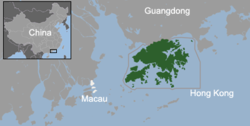
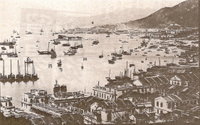
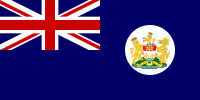


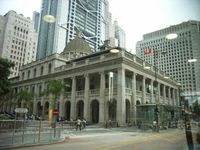
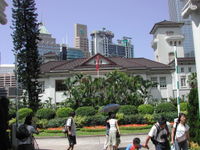
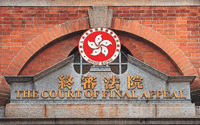

![A relief map of Hong Kong and the southern part of Shenzhen (circa 2000). ([2])](../../images/65/6585.jpg)
